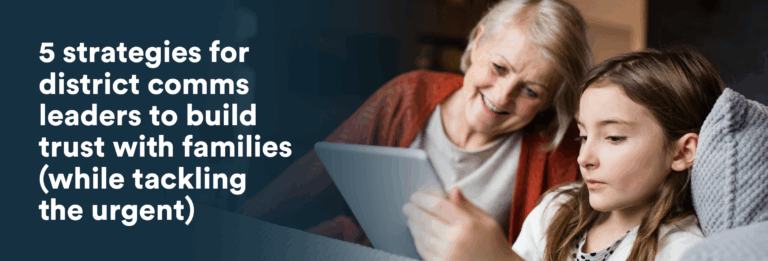Written by Heather Dooley
In schools and conferences across the country, everyone seems to be talking about AI (Artificial Intelligence) and ChatGPT.
Teachers are using ChatGPT to create lesson plans. Students are using ChatGPT to do their homework. And bloggers are using ChatGPT to draft content (although we promise not this one!).
We understand the opportunities these resources can bring to educators and families. As an innovative and tech-forward nonprofit, we built our universal family engagement platform using AI and ChatGPT. But we also recognize the need to approach new technologies thoughtfully and critically—and always with an eye for safety and equity.
As education philanthropist John Overdeck ponders in a recent article in The Chronicles of Philanthropy, “While technology should never be the primary mode of education, its potential to improve learning on a large scale cannot be ignored. The question is, what helps students — and what doesn’t?” He cites data from TalkingPoints’ quasi-experimental study and recognizes that “connecting with every family is both difficult and expensive. New tech tools, however, allow teachers to reach families who historically faced higher barriers to school engagement.”
While we are proud of our success, we begin this conversation with humility. Like most technological advancements, the opportunities and challenges are just beginning to become visible. Here’s some of what we have learned so far and predictions for what is to come:
1. ChatGPT and its many iterations are here to stay.
Much like search engines in the 90s and Wikipedia in the aughts, ChatGPT is shaking up the way students engage with information. This shake-up involves education organizations using AI technologies for everything from improving functionality and speed to promoting access and equity.
Used correctly, we believe AI technologies could allow teachers to prioritize critical thinking over memorization and rote activities. A survey commissioned by the Walton Family Foundation and conducted by Impact Research found 63% of students and 72% of teachers agreed with the sentiment that ChatGPT is “just another example of why we can’t keep doing things the old way for schools in the modern world,” and 73% of teachers said that the tool “can help students learn more.”
TalkingPoints has been using AI since the early days and ChatGPT since 2022. Our proprietary translation solution leverages machine learning with input from human translators. This combination has enabled TalkingPoints to continuously learn and adapt from customized training data. We also use AI for important features like suggested replies, speech-to-text and text-to-speech tools, and instant “Help Me Understand” on-demand translation support. This allows teachers to quickly draft messages with real-time support, so they can focus on building relationships with families.
2. We must be aware of biases that further exacerbate inequities.
These technologies may be here to stay, but they are still learned models based on imperfect information. ChatGPT is trained over time with billions of samples from the internet. It’s impossible to know what went into its training set from outside in, so we cannot prevent it from replicating biased patterns. As an algorithm, it often does not even understand it’s wrong unless it is told via human-driven feedback.
Importantly, since some voices on the web are louder than others, the algorithm has had less exposure to traditionally marginalized perspectives and will struggle to consider them. As we introduce ChatGPT technology into the education system, we must ask ourselves:
- Is the information provided culturally informed and responsive?
- Do families know how to frame questions to yield accurate information?
- Are families able to recognize inconsistencies or incorrect responses?
- What can we do to ensure accurate and helpful information that is contextualized for the education setting we operate in?
3. Families trust educators to provide accurate information about their child and the education system.
ChatGPT is great at providing a starting place, a first draft, a skeleton of a result. In schools though, this initial AI-generated response requires a thoughtful review by humans–for accuracy, empathy, relevance, appropriate tone, and/or translation–prior to being shared with students or families.
Why? Because as educators we build relationships on a foundation of truth and trust. Mistakes hurt these relationships, particularly among vulnerable or underserved populations.
We know from experience that accurate translations affirm a commitment to building a partnership between teachers and families. Impeccable translations and educational context are crucial for families. For many languages, ChatGPT hasn’t caught up with Google’s and Microsoft’s translation services. For us, TalkingPoints’ custom translation models have earned the trust of educators and families alike because we train the system with highly specific data, such as short-form, chat-based topics in the education domain. And yet, we still include an option for message re-translation via human review to maintain trust and strengthen the partnerships between educators and families.
4. ChatGPT can simplify processes and develop new access points.
In education, we often talk about barriers to student learning. Some of these barriers may be outside of a school’s locus of control, such as socioeconomic factors or family history. Others, however, may be addressable, including the many barriers that are created by unfamiliar processes and confusing systems.
In order to provide families with the greatest opportunities to support students, districts should consider specific uses for ChatGPT like:
- Guiding families through routine processes such as updating contact information or enrolling students in kindergarten, summer school, or clubs and activities.
- Answering common questions for families, particularly families for whom English fluency can be a blocker.
- Summarizing or simplifying complicated concepts or long messages.
- Translating a document, such as instructions for a project, for a family to help their child with schoolwork.
5. People’s expectations of a well-rounded education are shifting.
ChatGPT may be able to automate certain tasks, but it is still far from creating consistently contextually relevant and accurate responses, much less exciting and original work. In the years to come, teachers will need to design instructional experiences that stay ahead of the technological curve while leveraging technology to better differentiate, and students will need to develop their information and media literacy skills, domain knowledge, and creative capabilities to distinguish themselves. Teachers also will be able to spend more focus and time on the students and teaching versus administrative tasks that might be ‘outsourced’ to technology. Ultimately this well-rounded approach should serve students well and make instruction more dynamic and rewarding for learners and educators alike.
From our experience, ChatGPT produces merely average written composition now—and will continue to be perfectly average well into the future. Helping students develop their personal writing style and voice, as well as honing their editing and revision skills, will be increasingly important for them to stand out.
Re-envisioning Education
The opportunities of AI technologies like ChatGPT may seem boundless, but they require a strong human moral compass to guide them. Here at TalkingPoints, we remain optimistic about their future and focused on a mission that prioritizes human connection using the power of technology.
We realize that there’s really only one way to conclude a blog post about the future of AI in education. Ask ChatGPT to write it:
“In conclusion, the future of AI in education is a promising and rapidly evolving field with the potential to transform the way we teach and learn. As AI technologies continue to advance, we can expect to see their impact on every aspect of education, from personalized learning to intelligent tutoring systems. However, it is crucial to consider the ethical implications of AI and ensure that it is used in a way that supports and enhances human teachers rather than replacing them. By leveraging the power of AI in education, we have the opportunity to create a future where learning is more accessible, engaging, and effective for all students.”
About TalkingPoints
TalkingPoints is an education technology nonprofit that drives student success by removing critical barriers to equitable family-school partnerships, such as language, time, mindsets, and capacity. Ten of the country’s twenty largest school districts trust TalkingPoints to create a district culture where all families, no matter their background, can engage with their schools. Our simple, intuitive family engagement platform offers the highest-quality human- and AI-powered two-way translated communication available — in 145 languages and counting. Named by Common Sense Education as “the best overall family communication platform for teachers and schools”, TalkingPoints leads to higher test scores and lower absenteeism, as shown by rigorous causal research that meets the ESSA Tier 2 standard of evidence. To learn more, view our TED Talk or visit talkingpts.org.



